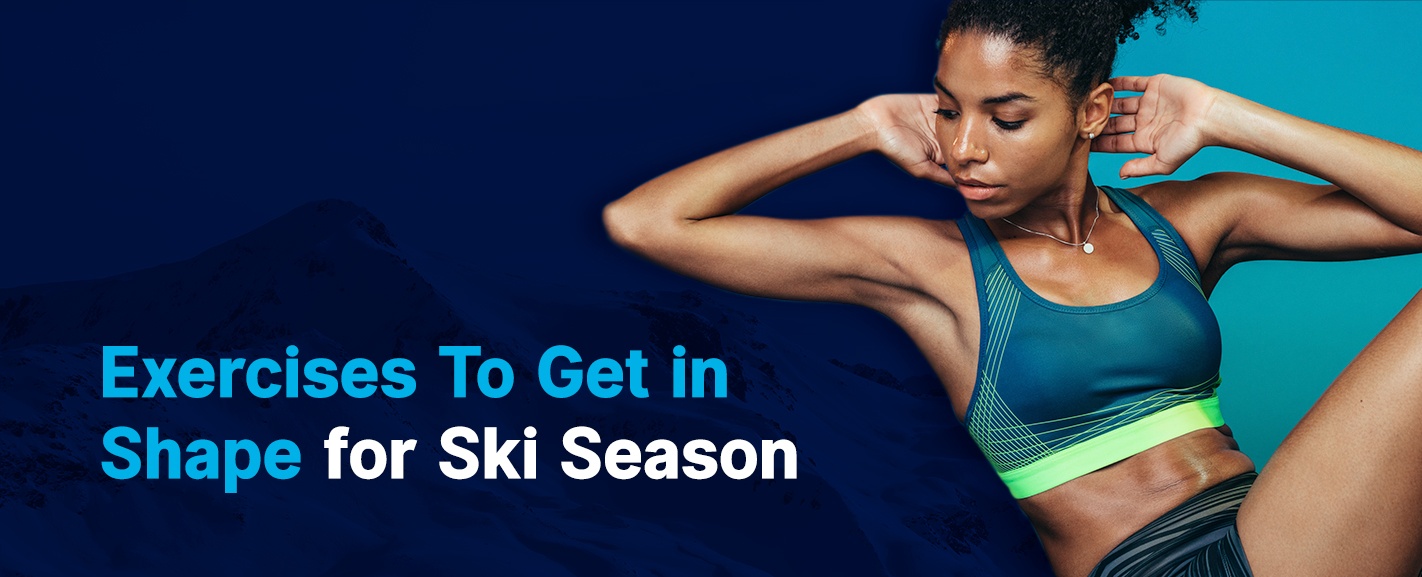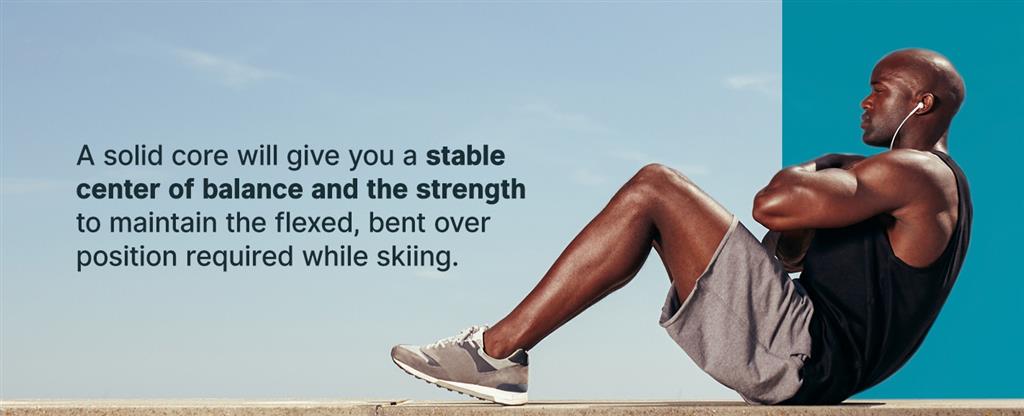 ski season exercises
ski season exercises
Exercises to Get in Shape For Ski Season
Posted
by
Buckman's Ski & Snowboard Shops
on Friday, September 25, 2020
For many of us, snow skiing is one of the main reasons to look forward to winter. But did you know you can be perfecting your ski skills even when there's no snow on the ground? Since skiing involves everything from cardio endurance to multiple muscle groups and core strength, doing ski strengthening exercises during the off-season can help keep you injury-free and having fun once the season rolls around.
To help you get ready for this winter, we'll take a look at why being in shape to ski is important, exercises to do to prepare for skiing, how to stay motivated and some ways to prevent injury on the slopes. If you're trying to get in shape for downhill skiing and looking for stellar off-season ski exercises, this is the article you've been searching for!
Do You Have To Be in Shape To Ski?
Skiing is so fun that you might not notice you're exercising while you're on the slopes, but you're working your entire body. In fact, snow skiing is a test of endurance, core strength and balance. This means trying to ski when you're not in skiing shape could lead to injury, excessive soreness, and overall not a very fun experience.
Because you can only ski during certain times of the year, you may not be able to do ski technique exercises all year-round. However, it's essential to stay active out of season, or your body won't be ready for the strain of skiing all day. To avoid injuries due to poor form caused by weak or fatigued muscles, you have to be in shape to ski. Even though you can't necessarily practice skiing all year, you can do some basic fitness exercises to keep your muscles prepped for long days on the mountain.
How Long Does It Take To Get in Shape for Ski Season?
If you really want to see progress in your skiing, you'll have to commit to doing exercises to get ready for ski season regularly throughout the weeks leading up to your trip to the slopes. The average skier can likely get by with working out just two or three times each week, but if you are more competitive about the sport, you might want to hit the gym more often. Start by working out a few days per week and build up from there if you have loftier goals.
5 Exercises To Get in Shape for Skiing
You know you should be working out, but what kind of exercises to train for skiing should you be doing? If you're stuck on where to start, consider incorporating these five exercises to be a better skier into your weekly routine.

1. Leg Exercises To Prepare for Skiing
Strong leg muscles are key to successful snow skiing because they're the muscle group you use most while on the slopes. Your leg muscles both hold you steady in position as you ski and protect your ligaments from injury. Here's a breakdown of how the five main leg muscles play their part and ways you can strengthen them:
- Quadriceps: This large upper-leg muscle is probably the most-used muscle in skiing. Solid quads are the key to avoiding nasty knee injuries like an anterior cruciate ligament (ACL) tear. Bulk up your quads with exercises like squats and lunges.
- Inner and outer thighs: You need your inner thighs to keep your skis together while your outer thighs keep you stable and enable you to steer. Tone these muscles through a variety of side lunges, leg lifts and side-step squats. Also, since they mimic the side-to-side movement of skiing, lateral plyometric jumps are ideal exercises to do before skiing to prepare your thigh muscles.
- Glutes: Because you lean forward from the hips as you ski downhill, your glutes work hard to stabilize you whether you're on the bunny slope or a black diamond run. Get them prepared for this important job by doing exercises like glute bridges and deadlifts during the off-season.
- Hamstrings: Your hamstrings are working equally as hard as your glutes to keep your body in a properly flexed position as you speed downhill. One-legged and regular deadlifts will help your hamstrings perform better, along with step-ups and hamstring curls.
- Calves: As a smaller leg muscle, the calves often get overlooked, but they are crucial to your skiing performance. Because your knees are continuously bent as you ski, the calves are constantly helping you stay upright so you don't faceplant. Calf exercises for skiing include jumping rope, toe-walks and calf raises, whether standing, holding weights or with a machine.
If you have a history of knee injury or just plain bad knees thanks to genetics, exercises like squats and lunges might hurt rather than help your overall health. Instead of overly stressing your knees, try low-impact ski exercises like kettlebell swings, banded lateral walks and donkey kicks. Some of the moves we already listed, such as deadlifts, hamstring curls, calf raises and glute bridges, are also great ski exercises for bad knees.
2. Upper-Body Exercises for Skiing
Along with your legs, your arms work hard to keep you balanced while skiing. Your arms have the important job of helping you push off your poles while keeping your shoulder joints stable. You'll need to keep your biceps, triceps and other major arm muscles in shape to prevent an upper-arm injury.
Here are three upper-body strength exercises for skiing:
- Push-ups: A classic show of strength, push-ups are the ultimate exercise for building arm, shoulder and chest muscle — and you can do push-ups right in your living room. All you have to do is place your hands on the floor slightly wider than your shoulder. Then, straighten your arms and legs before lowering your body until it hovers just above the ground and pushing back up. Repeat as many times as you can.
- Pull-ups: Another exercise that's great for your shoulders is the pull-up. Pull-ups are good for strengthening your back, too, but they do require some equipment. If you have access to a pull-up bar, all you have to do is hang from it and pull yourself up — which can be easier said than done!
- Burpees: Burpees have become a fitness phenomenon lately, gaining a reputation as a challenging whole-body move. To do a burpee, start in a standing position then drop to the ground for a push-up. As you push up, use that upward momentum to rise to your feet and jump as high as you can before dropping back down for another push-up. Repeat until every muscle is burning.

3. Core Exercises for Skiing
In the snow ski community, we're big fans of #abseveryday because a strong core is the foundation of any great athlete. A solid core will give you a stable center of balance and the strength to maintain the flexed, bent over position required while skiing. Building up your core can also help protect your spine from injury.
Here are three exercises for shredded abs:
- Sit-ups: Whether you do straight leg, crunches or V-ups, make sure you hit some version of this basic ab move. For a classic sit-up, simply lay on the ground with your knees bent and use your ab muscles to lift your chest up to your knees. Repeat.
- Planks: As a stationary exercise, planks may sound deceptively easy. Rest on your elbows in a push-up position while holding your body as flat and straight as a plank for as long as you can. This move works your all-around core and back muscles.
- Russian twists: Mix up your ab routine with some Russian twists. Sit on the ground and lift your legs out in front of you. You can keep them straight or slightly bent depending on your fitness level. Then, lean back just a little bit, making a V-shape with your legs and torso. Rotate your torso from side to side without putting your legs down. After a while, your obliques should be on fire.
4. HIIT Workouts
High-intensity interval training (HIIT) workouts are great if you have a busy schedule because they don't take a lot of time to do. Since you can't be high-intensity for a long time, HIIT workouts focus on quality rather than quantity of reps. Short, sweet and sweaty, this style of workout involves going all-out for a certain amount of time followed by a period of rest before continuing the cycle.
You can choose a HIIT workout solely focused on the lower-body or upper-body, or each interval can include a different muscle group. Another perk of HIIT is that the circuits can be totally based on bodyweight exercises so you can do them at home without worrying about having the proper exercise equipment. You can create your own custom HIIT workout to target whichever muscle groups you want with whatever equipment you have.
If you need some inspiration, here's an example of a basic HIIT workout. Aim for two minutes on, one minute off for as many rounds as possible of the following:
- 5 pull-ups
- 10 push-ups
- 15 bodyweight squats
The total amount of time spent doing HIIT intervals can be adjusted to suit your schedule or fitness level. If you're just starting your training, you might only get through a few rounds of a circuit. If you have time and are feeling good, though, go for more reps. For a reliable timer, check out the Flex Timer app. It's a free app that's set up to pair with a gym's clock. All you have to do is click "use without external device."
5. Low-Intensity Steady State Cardio
You'll want to improve your cardiovascular health and be able to sustain a slightly elevated heart rate so when you hit the slopes, you can breathe easily and enjoy your time in nature. Ski conditioning exercises like cardio training are especially critical if you're headed west, where you'll be at a higher altitude. We recommend two or three sessions of 30-60 minutes per week of a low-intensity cardio exercise, such as biking, jogging, swimming or even hiking.
How To Stay Motivated During the Off-Season

Now that you know how to prepare for ski season with the best ski training exercises, it's time to talk about motivation. We'll be honest — keeping your eyes on the prize can be tough when there's not a mountain in sight. But stick with off-season training, and you'll be able to conquer the mountain in-season.
Here are three tips to stay motivated when the off-season seems to drag:
- Grab a friend: Having a workout buddy is always more fun than exercising alone. Working out with others can also help keep you accountable and consistent — and when you know you're meeting a friend, you might even start to look forward to your exercise regime!
- Get in the groove: Making a clear workout plan will give you a reliable routine to follow even on days you don't feel like it. Pick a workout routine you can get excited about with a fun mix of movements and enough of a variety so that you don't get bored.
- Set a goal: When you sit down to make your plan, set some goals, too. Make some short-term goals to give yourself some smaller rewards, which will help you stay focused, along with your long-term goal of skiing like a pro. Keep training — the snow will be here before you know it!
How To Prevent Injury During Ski Season
After working so hard during the off-season to get in shape, you'll want to be sure to stay healthy throughout all of ski season. Make the most of the snowy months by remembering to properly warm-up and cool down when skiing. Follow these tips for taking care of your muscles when you ski to keep them injury-free:
- Do ski warm-up exercises: After many months away from the sport, you can't walk straight from the lodge to the lift without warming up. Do some dynamic stretches to get your blood flowing and muscles ready for the dynamic sport that skiing is. To prevent getting stiff, you can even do some of these dynamic moves while on the lift, as long as you're careful and use the safety bar.
- Cool down after skiing: Even though you might be cold by the time you're done skiing, you still need to cool down. Your cool-down routine should involve static stretches to improve your flexibility and range of motion. Static stretches are moves that are traditionally associated with stretching, like touching your toes or the butterfly. These stretches will keep your muscles supple and ready for another day on the slopes.
Shop Buckman's Ski and Snowboard Shops To Get Prepared for Ski Season

Once the snow finally starts to fall, you'll need some gear to keep you warm as you show off your fitness on the slopes. Shop Buckmans.com for the best skiing brands online. We have a wide variety of ski gear and apparel to keep you warm and dry even in the coldest, wettest conditions.
At Buckman's Ski and Snowboard Shops, we're passionate about skiing, snowboarding and enjoying the mountains with friends and family. That's why we carry only the highest quality ski supplies for our fellow winter enthusiasts. Get ready for ski season by visiting your online mom-and-pop ski shop today!
Categories:
Ski & Snowboarding Tips
Tagged: ski, snowboard